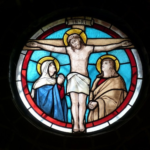We run our website the way we wished the whole internet worked: we provide high quality original content with no ads. We are funded solely by your direct support. Please consider supporting this project.

God’s Kind of Warfare
Over and over, and in a variety of different ways, we are told that, while “[s]ome trust in chariots and some in horses,” Israelites were to “trust in the name of the LORD our God” (Ps 20:7), for “[n]o king is saved by the size of his army” and “no warrior escapes by his great strength.” Yet, “the eyes of the LORD are on those who fear him” and whose “hope is in his unfailing love” to “deliver them from death” (Ps 33:16-9). And while Yahweh frequently promised the Israelites they would be blessed if they placed their complete trust in him, he just as frequently warned them that there would be terrible consequences if they placed their trust in anything or anyone else (see Isa 31:1, Ezek 33:26; Hos 10:13).
Passages like these suggest that, had the Israelites been able and willing to trust Yahweh to “fight” their battles, they never would have needed to lift a sword. Unfortunately, while the Israelites had no problem trusting Yahweh to help them use their swords to conquer enemies, they had great trouble trusting Yahweh instead of their swords. As Vern Eller has pointed out, the one thing the ancient Israelites seemed incapable of understanding was that “MAN IS NOT THE ENEMY” (see Eph 6:12). While everybody in the ancient world trusted their god to help them fight, no one ever dreamed that their god didn’t want them to fight in the first place! And this included what most Israelites expected of Yahweh.
We catch a glimpse of the kind of warfare Yahweh would have liked his people to use in the remarkable story of Elisha’s victory over the Arameans in 2 Kings 6. Elisha’s prophetic gift had enabled him to help the Israelites avoid being ambushed by the Arameans several times. Frustrated by this, the king of Aram sent his army to capture Elisha (vv. 13-4). When Elisha and his servant saw that they were surrounded, the servant was understandably terrified. But Elisha prayed for his eyes to be opened, at which point the servant saw “the hills full of horses and chariots of fire all around Elisha,” referring, of course, to the army of heavenly warriors that were on their side (v.17).
At Elisha’s beckoning, the Lord temporally blinded the Aramean army, at which point Elisha volunteered to lead them “to the man you are looking for” (vv.18-9). When the Lord restored their sight, this army found themselves in the court of the Israelite king. The Israelite king suggested that they take advantage of this fortunate opportunity and slaughter the Arameans. But, to everyone’s surprise, Elisha instead instructed the king to throw them a banquet and send them back home (v. 22)!
Now that looks like the way Jesus would fight. It also looks completely unlike the way any other army (or any other in the history of warfare for that matter) ever fought. Elisha’s decision to “not repay evil with evil” but to instead “overcome evil with good” (Rom 12:17, 21) inspired Aram to bring their military campaign against Israel to a complete and permanent halt (2 Kg 6:23).
How might the Spirit of God be leading you to respond to evil with good today?
—Adapted from Cross Vision, pages 112-114
Category: General
Tags: Crucifixion of the Warrior God, Cruciform Theology
Verse: 2 Kings 6
Related Reading

When the Last Few Moments Changes Everything
One of the central things ReKnew wants to accomplish is to challenge followers of Jesus to accept that the self-sacrificial love Jesus revealed on the cross is the definitive, and even the exhaustive, revelation of God’s character. Everything about God, we believe, should be understood through the lens of the cross. For most Christians, Jesus…

Cruciform Theology in Four Steps
The culmination of the biblical narrative of the cross reframes everything about who God is, what it means to have faith in God, and how we read the Bible! The entire Old Testament leading up to the crucified Christ must be interpreted with a view toward discerning how it anticipates and points toward this definitive…

How God Judges Sin
In his third sermon covering material from his book Crucifixion of the Warrior God, Greg explores the topic of judgment. In this clip, Greg suggests that while God certainly does judge sin, how he judges is very different than we might expect. You can view the entire sermon here on the Woodland Hills Church site. You can find the…

A Cruciform Dialectic
One of the most important aspects of God’s action on Calvary, I believe, is this: God revealed himself not just by acting toward humans, but by allowing himself to be acted on by humans as well as the fallen Powers. God certainly took the initiative in devising the plan of salvation that included the Son…

It’s All About the Crucified Christ
The world was created by Christ and for Christ (Col 1:16). At the center of God’s purpose for creation is his plan to unite himself to us in Christ, reveal himself to us through Christ, and share his life with us by incorporating us into Christ. We don’t know what this might have looked like…

God’s Love is Cruciform
Paul instructs us in what it means to follow Jesus, when he stated, “Follow God’s example, therefore, as dearly loved children and walk in the way of love, just as Christ loved us and gave himself up for us as a fragrant offering and sacrifice to God (Eph 5:1-2). Here Paul defines what it means to…
